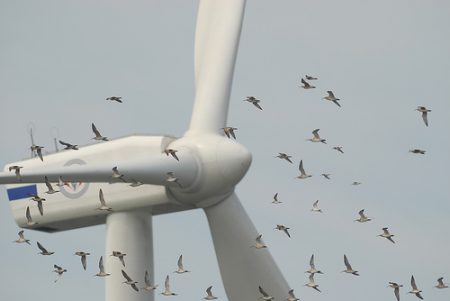December 10, 2017 – In June this year, President Donald Trump held a rally in Cedar Rapids, Iowa, where he praised coal and criticized wind energy. He pointed out that wind turbines kill birds. He isn’t wrong. Wind turbines do impact bird populations, causing between 140,000 and 368,000 to die annually. And although that number seems high it doesn’t even come close to bird deaths caused by cell phone towers (6.8 million) and glass buildings (1 billion) every year.
Trump hates wind power not because of the birds. He hates it because he fought to stop the installation of offshore wind turbines off the coast of a golf course he owns in Aberdeen, Scotland because it would destroy the aesthetics of his property. That was back in 2012. He made many other Twitter comments about the ugliness of wind turbines well before he glommed onto the bird death argument. Even stranger, when Trump visited Iowa during the election campaign in 2016, he told his audiences he favoured the wind industry, supporting subsidies for the building of turbines.
There have always been questions about the potential impact wind turbines could have on local ecology and climate. Back in 2016 in a study published in Environmental Research Letters, was the first to measure climate impacts from these structures when placed in close proximity. In measuring temperature and humidity at a site in Scotland consisting of 54 turbines, it was noted that these facilities did alter local climate. But the impact was marginal amounting to two-tenths of one degree Celsius in temperature rise at ground level within the wind farm.
Stephen Mobbs, Director of the National Centre for Atmospheric Science, University of Leeds, and lead author in the study, noted that wind turbines created such a small impact that it was nearly negligible. On nights when normally cold air sinks to the ground, the turning of the wind turbine blades pushes the warmer air above it downward. Hence the increase in ground temperatures in the vicinity of wind farms. Mobbs notes that forests create a much larger impact than a wind farm in relation to changes in climate.
And as for wildlife impacts, both birds and bat collisions represent a continuous challenge despite the fact that wind turbine structures are far less of a hazard than other human construction. In the book Environmental Impacts of Wind-Energy Projects, produced by the Division on Earth and Life Studies, National Research Council, Washington, DC, estimates of bird deaths from all kinds of human activities are noted including:
- vehicle impacts, 80 million birds annually
- high-tension power lines, 130 million birds annually
- toxic chemicals, and pesticides, 72 million birds annually
- cats, hundreds of millions annually
Comparatively, wind turbine fatalities represent less than 0.003% of anthropogenic-caused bird deaths. Statistics for bat deaths from wind farms is less understood with very little published data. But according to a report done for the Union of Concerned Scientists, entitled Environment Impacts of Wind Power, the impact of spinning turbines poses a relatively low threat to bat populations. In the case of bats, the greatest threat occurs when wind speeds are low. As a result, the Bats and Wind Energy Cooperative recommend that wind farm operators keep turbines motionless in low-wind conditions.
Do the statistics vary from land-based to offshore wind farms? Apparently not with studies showing minimal impact on marine birds, and virtually zero impact on bats. But offshore wind farms do have other ecological impacts. Studies show that the turbines impact sea life because their foundations are natural attractors for living creatures. Shellfish attach themselves to the concrete bases. And where there are shellfish, other fish populations increase, using the platforms as artificial reefs. In a recent study of wind farms on the North Sea, as reported in the October 14, 2017, edition of The Economist, these offshore platforms are becoming “a particularly enticing home for a type of tasty, edible mollusc called the blue mussel.” This extra habitat is currently equal to 20% of the natural mussel beds found in the North Sea. The consequences of increased mussel populations will alter plankton populations in the vicinity of these wind farms which the study predicts will fall by as much as 10%. This could impact populations of anemones, scallops, jellyfish and other species reliant on plankton, and, subsequently, fish, seals, seagulls and other larger animals higher up in the food chain.









